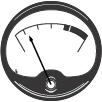3. Electronic Music Systems
The environment in which a musician shapes and manipulates representations of sound may loosely be called an electronic music system. The actual tools available can vary widely from system to system, with each system having its own virtues and limitations. In general, though, these systems operate on the same principles of conversion and representation outlined in "Sound as a Representation".
Some systems "capture" sound with a microphone, allowing the musician to pull the sound into the realm where it becomes a representation of sound that may be shaped and manipulated and then turned back into acoustic energy--or sound.




 Sound Source
Microphone Captures Sound
Electronic Music System Shapes and Manipulates
Speaker Converts Back to Sound
Sound Source
Microphone Captures Sound
Electronic Music System Shapes and Manipulates
Speaker Converts Back to Sound
Example 3-1: Some systems "capture" sound with a microphone allowing the musician to pull the sound into the realm where it becomes a representation of sound that may be shaped and manipulated and then turned back into acoustic energy - or sound.
Some electronic music systems are not able to "capture" outside sound but instead have "preset" representations of sound that can be manipulated by the user. The process is identical to the previous example but with the first two parts removed.
Diagram 3-2: Preset representations of sound.
The shaping and manipulating of representations of sound by an electronic music system is known as synthesis. There are many ways to "synthesize" sound. The methods vary widely and depend on the system being employed. Even so, fundamental concepts and techniques are shared by many synthesis environments in which a musician may work.
The term synthesizer refers to instruments that produce user-designed analog or digital representations of sound that are subsequently changed to acoustic energy. A synthesizer can be an instrument dedicated exclusively to sound synthesis or a computer programmed to synthesize sound.
When an instrument represents sound as voltages, that instrument is an analog synthesizer.
Example 3-3: An analog synthesizer represents sound as a fluctuation in voltage, which can be sent to an amplifier, and then to a speaker where it is converted to acoustic energy.
If an instrument represents sound as a series of discrete numbers, that instrument is a digital synthesizer.
Example 3-4: A digital synthesizer represents sound as a series of discrete numbers, which are converted to an analog signal just before they are output from the synthesizer.
A computer that carries out the same tasks as a synthesizer is producing computer music. A software program in the computer is the synthesizer which, like a digital synthesizer, represents sound in a digital form. An analog or digital synthesizer, or a computer running a sound generating program, can be called a synthesis system or synthesis environment.
Electronic Music Interactive uses electronic music as a general term to describe any music created with synthesizers, computers, or related instruments. Although there are many small differences among analog synthesizers, digital synthesizers, and computers used as synthesizers, the primary difference lies in the way sound is represented in each system during the synthesis process. Despite these differences, however, the concepts and techniques governing each are basically the same. What follows is a survey of the fundamental knowledge necessary for work in any electronic music system.












